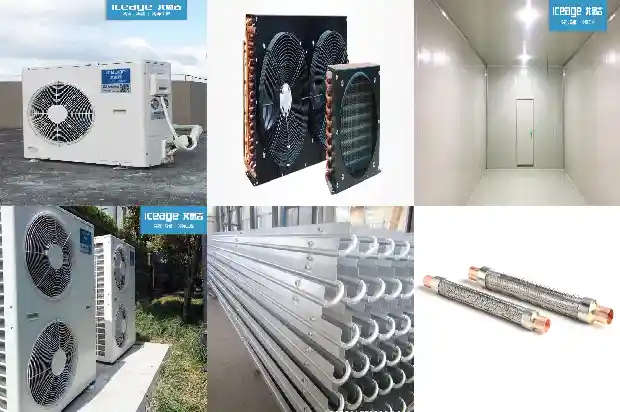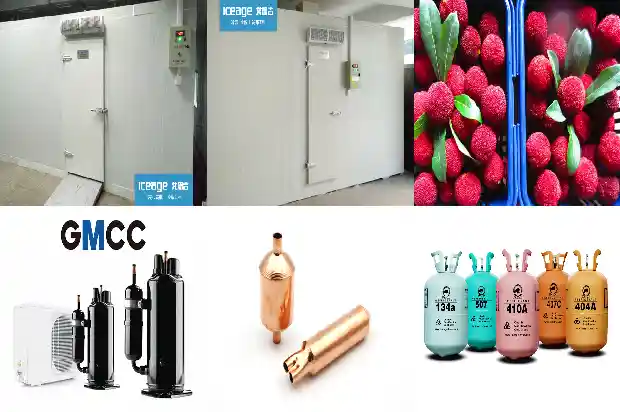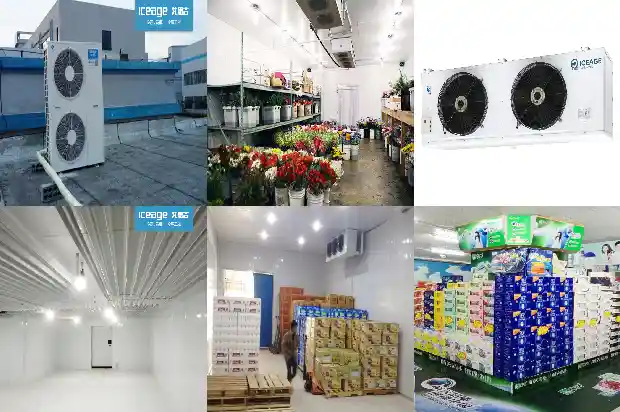Introduction to Air-cooled Chiller
2024-09-21
Air-cooled chillers directly use the air-cooled condenser on the unit to discharge heat into the air. Air-cooled machines are used in areas with water shortages or where it is inconvenient to access water. Compared with water-cooled chillers, air-cooled chillers use finned condensers and directly use fans to force air flow to take away the refrigerant heat without the need for other auxiliary equipment, eliminating the need for cooling towers, cooling water pumps, and cooling pipeline systems. It has certain advantages in installation, especially for small chillers with small cooling capacity requirements, and its convenience in movement has great advantages.
Due to different heat transfer temperature differences, under the same outdoor environmental conditions, the condensing temperature of air-cooled chillers is higher than that of water-cooled chillers. Therefore, under the same cooling capacity, the power consumption of air-cooled chillers will be higher. In terms of energy efficiency, usually water-cooled units have a cooling capacity of 300-500 Kcal/h higher than that of air-cooled units.
Air-cooled chillers avoid the problems of condenser scaling and water pipe blockage caused by poor water quality in areas and save water resources. However, the heat exchange efficiency of the finned condenser used is greatly affected by the accumulation of ash and dirt. A dust filter grid must be set in front of the heat dissipation finned tube and regular cleaning is required.
Application fields
Pharmaceuticals, chemical industry, food, grease, coating, electroplating, cold storage, plastics, chemical fiber, commercial concrete, laser, purification workshop, mechanical processing, agricultural planting, shopping malls, hotels, etc.
Pharmaceuticals, chemical industry, food, grease, coating, electroplating, cold storage, plastics, chemical fiber, commercial concrete, laser, purification workshop, mechanical processing, agricultural planting, shopping malls, hotels, etc.
Precautions
Air-cooled series chillers must be installed in a spacious and ventilated place (such as outdoors, on the roof, etc.), and at the same time ensure that the air duct system is unobstructed.
Air-cooled series chillers must be installed in a spacious and ventilated place (such as outdoors, on the roof, etc.), and at the same time ensure that the air duct system is unobstructed.
Differences between air-cooled and water-cooled:
- In terms of the size of the equipment, due to the differences in working principles between the two, the air-cooled chiller is smaller in size than the water-cooled chiller, and its use and later maintenance are also relatively simpler.
- From the perspective of the efficiency and price of the machine, the water-cooled equipment is more powerful than the air-cooled equipment, and it also consumes less power. Although the water-cooled equipment occupies a larger area, the price is much cheaper than the air-cooled equipment.
- The price of water-cooled equipment is relatively lower, but a special machine room needs to be built when in use. However, air-cooled chillers do not need this. So if there is no suitable site, it is more appropriate to choose air-cooled equipment.
Selection of installation location for air-cooled chillers
Four main factors to be considered:
Four main factors to be considered:
- Distance between air-cooled chiller and temperature-controlled equipment: The distance between the air-cooled chiller and the temperature-controlled equipment should be minimized. The advantage of this is that it can reduce the pressure drop and cooling loss of chilled water in the pipeline. When the unit does not have a remote control function, it is convenient to operate the equipment.
- Impact of noise from air-cooled chillers: The noise of air-cooled chillers mainly comes from several components such as compressors, circulating water pumps, and fans. Among them, the noise of fans is the main one. The noise of conventional small air-cooled chillers is still relatively small, generally around 65 dB(A), and can be used in ordinary indoor environments. If it is used in places with noise reduction requirements such as laboratories, the noise reduction problem of chillers needs to be considered. For air-cooled chillers with more than 20HP, it is recommended to install them in an outdoor environment slightly farther from the working environment of personnel.
- Water supply and drainage requirements: Air-cooled chillers may need to supplement a certain amount of circulating water during use and later maintenance. Therefore, the installation location should consider a water source for automatic water replenishment and the convenience of draining the circulating water during equipment maintenance. If the air-cooled chiller adopts manual water replenishment, only the drainage problem of the equipment needs to be considered.
- Chiller installation environment: In terms of heat dissipation conditions, installing air-cooled chillers outdoors is better than installing them indoors. Because there is a good ventilation environment outdoors, the heat brought out by the unit can be discharged in time. However, since outdoor units adopt a unit structure design that is windproof and rainproof, the price will be more expensive than that of ordinary chillers. In addition, considering that in order to facilitate unit operation, it is very necessary to remotely connect the control and fault feedback parts of the chiller to the indoor.
Maintenance and inspection of air-cooled chillers
- Check the stability of voltage and current.

- Regularly inspect the compressor.
Perform necessary acceptance tests on the chiller in accordance with the principles of air tightness test first, then vacuum test, sub-item test first, and then whole machine test. - Regular cleaning
In addition to checking the technical performance of the chiller, pay attention to protecting the clean appearance of the unit and the cleanliness of the work site. When the air-cooled chiller operates for 6 months, the entire system should be cleaned, such as pipelines, filters, condensers, fans, etc. Especially for fans, just like the fans we commonly use, when they are covered with dust and affect heat dissipation, the refrigeration efficiency will be directly reduced. - Regularly check the instrument.

If the temperature control meter is out of control, replace the temperature control meter. High pressure fault, poor heat dissipation, the radiator is too dirty, clean the radiator. Poor ventilation, improve ventilation conditions. The cooling fan does not work. Check whether the fan motor is burned out or short-circuited.
Repair or replace the motor. The high voltage support is damaged. Replace the high voltage support.
- Regularly check whether the refrigerant is reduced.
Judge according to the high and low pressure gauge values on the front of the air-cooled chiller. When the chiller is operating normally, a high pressure of 11-17 kg and a low pressure of 3-5 kg are within the normal range. When the chiller is in a shutdown state, both the high pressure and the low pressure are about 0.6 kg.
The efficient refrigeration function of air-cooled chiller products is inseparable from their daily maintenance and safety inspection. Therefore, it is very important to frequently check the operating conditions of air-cooled chillers. In addition to the above several main inspection aspects, also pay attention to checking the oil level and oil temperature of each compressor, checking the main power supply voltage and current, and checking whether the set value of the chilled water supply temperature is appropriate. If there is a problem, it should be changed in time.

Related Articles
- Introduction to Inspection and Handling Methods for Refrigerant Leak in Cold Storage
- Introduction to Control Valves in Refrigeration Systems
- Introduction to Basic Types of Cold Storage
- Introduction to Lithium Bromide Absorption Chillers
- Introduction to the Advantages of Dual - temperature Cold Storage
- Introduction to Various Water Tanks in Air - conditioning Systems
- Introduction to the Cleaning Processes and Methods of Heat Exchangers and Cooling Towers
- Introduction to Six Kinds of Two-stage Compression Refrigeration Systems
- Introduction to Key Points of Compressor Grouping in Quick-freezing Cold Storage
- Introduction to the Construction and Features of Cold Storage in Cold Chain Logistics
- All-round Introduction to Condensers and Evaporators!
- Introduction to Vapor Barrier of Cold Storage and Moisture Protection of Equipment
- Introduction to Oil Collector in Refrigeration System
- Technical Introduction of Process Cooling Water System
- Introduction to Five Classification Functions of Cold Storage Installation for Refrigeration
- Introduction to Precooling Methods for Fruits and Vegetables
- Introduction to the Relationship between Refrigerants and Cold Storage Temperatures
- Introduction to Types of Condensers in Cold Storage
